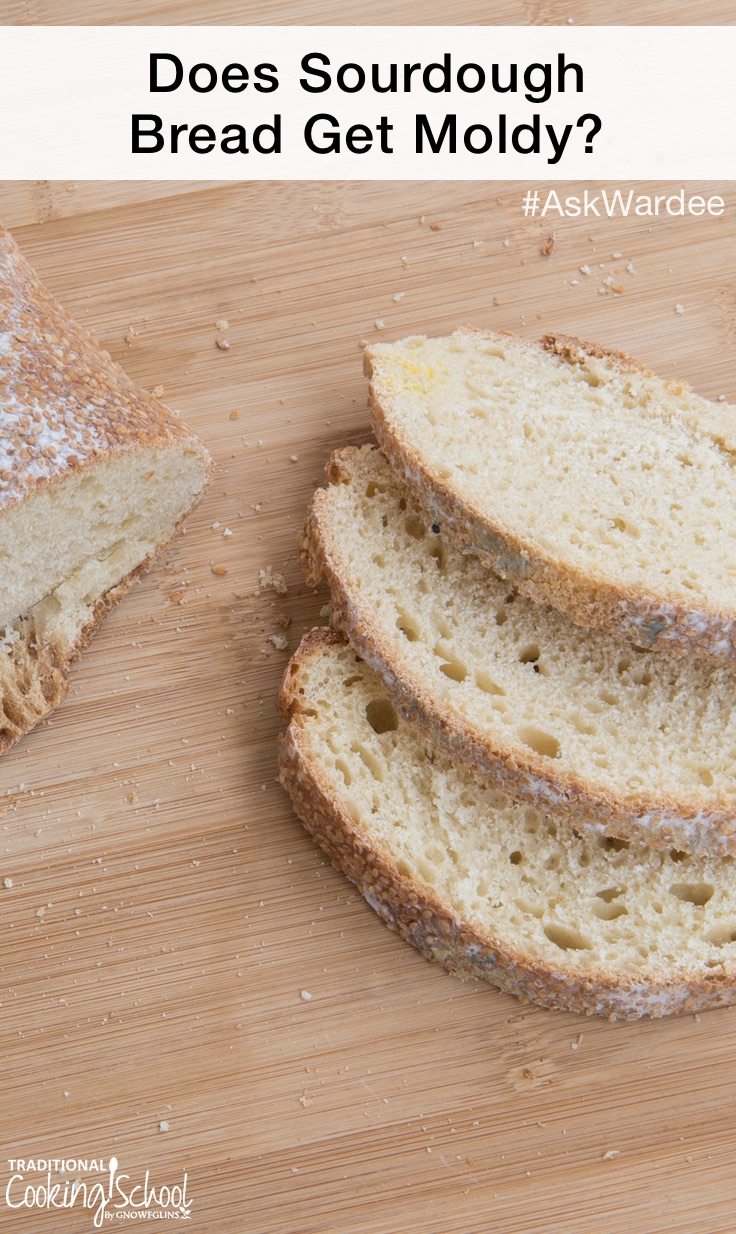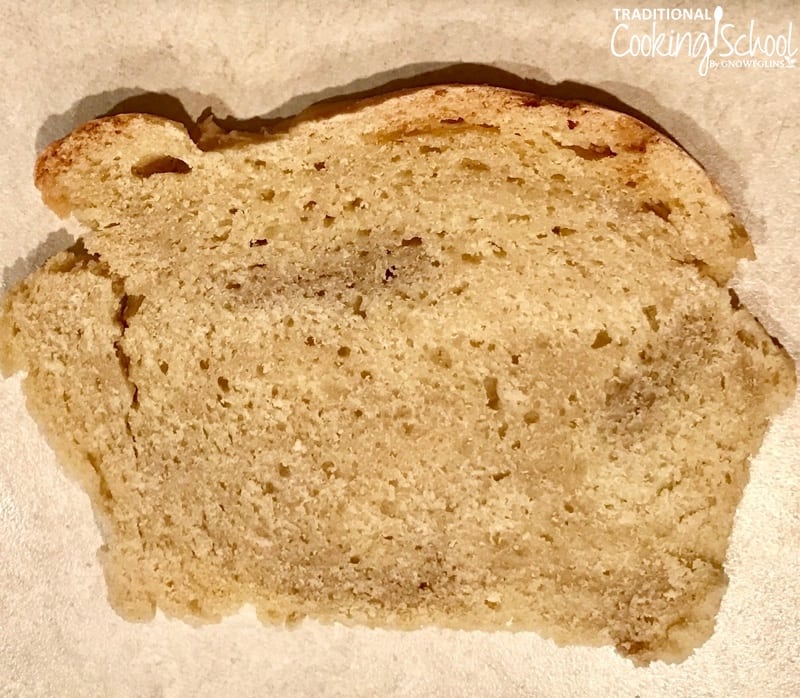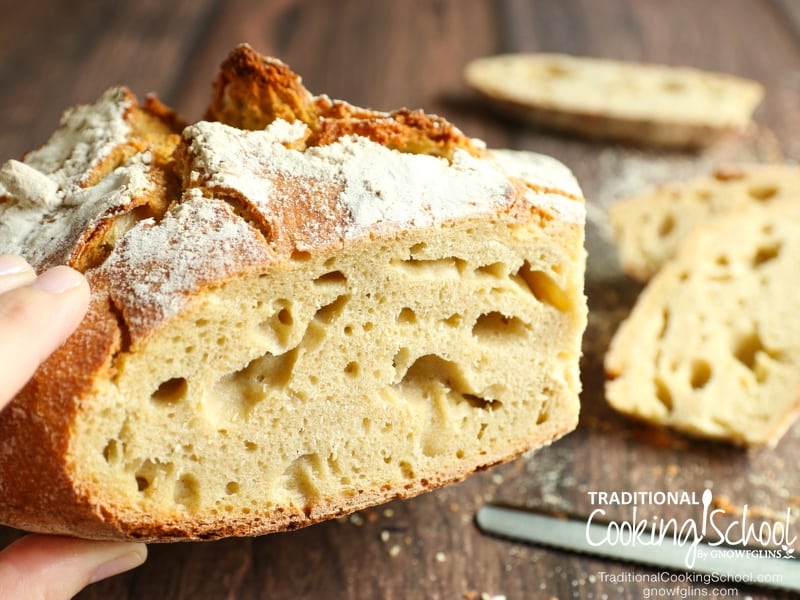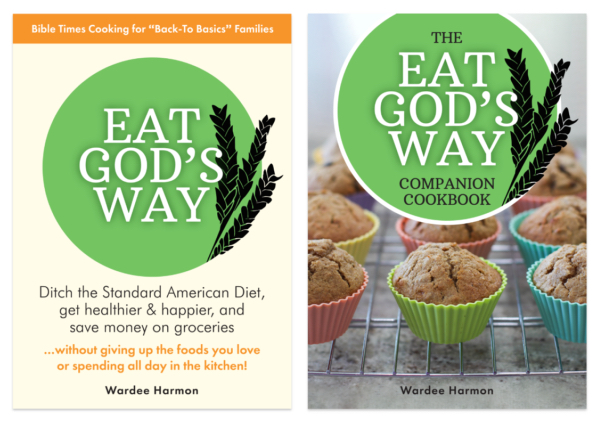
“I thought sourdough bread wasn’t supposed to mold that fast!” is a common email we receive.
Recently, Julie P. sent an image and info about her sourdough bread woes… including what she thinks is mold at 3 days. She too is wondering if her sourdough bread should have molded that quickly.
And, she’s asking for guidance on lightening up her loaf. The dough was dense and didn’t seem to get baked all the way through when following my recipe for No-Knead Einkorn Sourdough Bread.
Julie, let’s troubleshoot your bread woes on today’s #AskWardee… so it turns out great next time! 🙂
Read, listen, or watch below!
Subscribe to #AskWardee on iTunes, Stitcher, YouTube, or the Podcasts app.
Q: Does Sourdough Bread Get Moldy?

Julie P. asked:
Thank you for your past help. I tried to make the loaf pan and roll sourdough bread per the recipe (No-Knead Einkorn Sourdough Bread). It didn’t go really well. The dough didn’t rise and then the bread was very dense, no air pockets even though cooked the correct time. What went wrong? Do you have suggestions?
Also, after three days it molded. See attached picture (above). Is that normal for it to mold that fast? I want to try again but would love some guidance as to what to do differently. Thank you so much.
Troubleshooting Your Sourdough Bread
I’m happy to help, Julie!
Are the dark spots what you’re thinking is mold? If so, I don’t think that’s mold — that’s where the baking soda didn’t get mixed in well enough.
Your bread does look underdone, which can happen with a denser dough that you’ve mentioned. A longer bake would help.
So would improving the texture of the dough so it’s not so heavy. I give many tips on lighter, less dense bread in this Ask Wardee #053: Less Dense Sourdough Bread.
In #AskWardee 018, I shared my own daily sourdough routine, which involves what I call “daily maintenance amounts”. Go here to get all my best feeding tips.
Even though I talk about using small amounts of flour for feeding (in episode #18), keep in mind that you should also make sure the starter is getting enough food to support the work of rising bread dough. It’s different for everyone. Your clue to whether your starter is strong enough is the daily activity it shows — bubbles, yeasty/fresh smell, etc.
If your starter doesn’t rise the bread and isn’t as active, it might need to be fed more at each feeding or might need more frequent daily feedings, like three instead of two. Go with small-enough amounts of flour so you don’t overwhelm your life and to be frugal with flour, but not with amounts so small that the starter suffers and doesn’t perform well.
By the way, here are instructions for creating an einkorn sourdough starter.

When You Try Again…
When making the No-Knead Einkorn Sourdough Bread (pictured above), try again by:
- Taking the day or two leading up to baking and give the starter plenty of food and TLC so it’s really strong and active. This also ensures it has plenty of acid to react with the baking soda to add extra lift.
- If you aren’t already, use fresh-milled flour for a lighter result — the mill we love and use daily is the Mockmill home stone grain mill. (Limited time: get 2 free eBook packages from me with your purchase!)
- Sift your flour before making the dough (if not using fresh-milled flour).
- Rising your dough at a warm room temperature.
- Those brown spots in your bread are signs the baking soda wasn’t worked in well enough — so do a few more folds to ensure it is mixed throughout.
- Bake longer if the dough is dense, so it cooks all the way through. You can cover the top with parchment paper near the end so it doesn’t get too brown.
What About Mold?
Even though sourdough bread’s natural composition resists mold, due to the vinegar produced by the sourdough starter’s organisms, it does still mold eventually. How long depends on the doneness of the dough, how it’s stored, and the humidity/temperature conditions.
Certainly, if it’s not baked all the way through, it can mold in three days … or less! If it’s humid or warm, any bread will mold in three days or less.
I don’t like to keep our bread at room temperature as long as three days because homemade bread dries out faster. I pre-slice it and keep in the freezer and take out just what’s needed for that day, or even on the spot to put in the toaster because it’s pre-sliced. Then you have fresh bread on any day.
Also… the toaster can help bake under-done bread a little more. Keep it in the freezer until toasting and it will maintain its current state without molding. 🙂
Helpful Links
- FREE No-Knead Einkorn Sourdough Bread Recipe
- Mockmill home stone grain mill — Limited time: get 2 free eBook packages from me with your purchase!
- Ask Wardee #053: Less Dense Sourdough Bread
- #AskWardee 018: What’s Your Daily Sourdough Routine?
- How To Make An Einkorn Sourdough Starter
More Sourdough Posts from the #AskWardee Show:
- When Is A Sourdough Starter Ready For Baking? #AskWardee 145
- Sourdough Tips, Troubleshooting & Frequently Asked Questions
- Sourdough Troubleshooting: How To Know When Your Starter Is Strong Enough For Bread-Baking
- The Best & Healthiest Flours For Sourdough #AskWardee 065
- Feeding Your Sourdough Starter… More Than Just Flour! #AskWardee 150
- Is Aged Flour *Really* Better For Sourdough? #AskWardee 122
- Can I Use Reverse Osmosis Water For Fermenting, Culturing, & Sourdough? #AskWardee 138
- How To Transition A Sourdough Starter To Einkorn #AskWardee 069
What Is The #AskWardee Show?
The #AskWardee Show is the live weekly show devoted to answering your niggling questions about Traditional Cooking: whether it’s your sourdough starter, your sauerkraut, preserving foods, broth, superfoods or anything else to do with Traditional Cooking or your GNOWFGLINS lifestyle.
I share tips and resources, plus answer your questions about Traditional Cooking!
The Details
When: Wednesdays at 10am Pacific / 1pm Eastern
Where: Traditional Cooking School on Facebook Live
What If You Can’t Make It?
Don’t worry. You can catch the replays or listen to the podcast!
- Come back here to AskWardee.TV; all replays will be up within hours of airing live; the print notes are always posted at the same time I go live.
- Go to Traditional Cooking School on Facebook to view the Facebook Live replay.
- Subscribe to the #AskWardee podcast on iTunes, Stitcher, YouTube, or the Podcasts app. While you’re there, be sure to leave a rating and review!
Want To Get YOUR Question Answered?
Here’s how to submit your question. If we answer it on #AskWardee, you’ll get a gift!
- Tweet your question to @TradCookSchool on Twitter; use hashtag #AskWardee
- Send an email to wardee at AskWardee dot tv — add #AskWardee to your email so I know it’s for the show
Please do NOT add future questions for #AskWardee to the comments of this post because they might get missed!
How long does your sourdough bread last? How do you ensure a light, well-baked loaf?
...without giving up the foods you love or spending all day in the kitchen!

2 free books:
Eat God's Way
Ditch the Standard American Diet, get healthier & happier, and save money on groceries...
We only recommend products and services we wholeheartedly endorse. This post may contain special links through which we earn a small commission if you make a purchase (though your price is the same).


I normally make the no-knead Einkorn sourdough bread in my Dutch oven which makes one loaf so when you use a loaf pan, does it make one or two loaves? What type and size of a loaf pan do you use, (glass, tin, ceramic etc)? When baking the bread in a loaf pan, do you need to cover the bread as it bakes?
Jeanette, I generally use a loaf pan when I make bread (I don’t have a Dutch oven). I usually fluctuate between a big, what I call industrial size loaf pan, and a “normal” size (of which I use two when making this recipe. Mine are metal, but I have some smaller ones that are a type of glass. I generally do not cover the bread. I might bake longer and cover it for the final, say, twenty minutes at a lower temperature since my most recent loaf came out underdone.
Wardee, can you please give us the inch size of your loaf pans? My pans tend to not be exactly straight sided. I suppose you get two loaves in the loaf pan with the No Knead Einkorn recipe.
Hi Linda,
Here are the loaf pans Wardee ues: http://amzn.to/2CMp454 They are 8.3 x 5 x 4 inches.
She doesn’t quite get 2 loaves so that’s why she increases the recipe 250% to get 3 loaves at a time.
I measure the temperature of my loaves that are very large in the dutch oven with an instant read thermometer to 200 degrees.